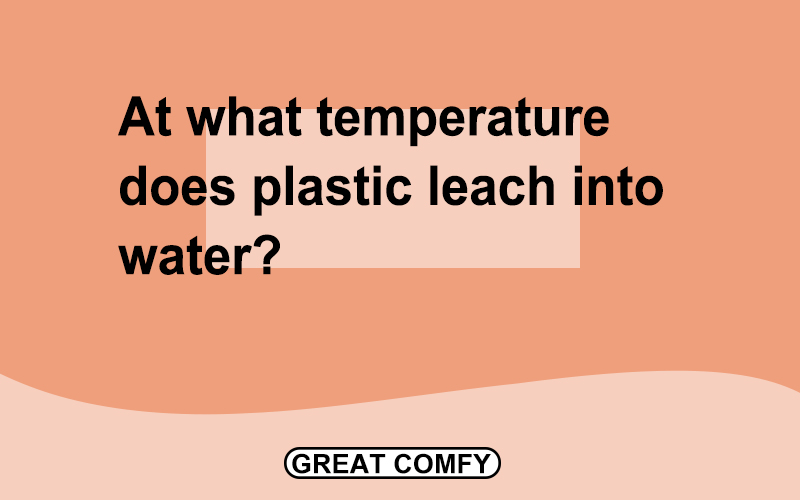We often take it for granted, but plastic is a constant presence in our lives. But how much do we really know about it?
For instance, at what temperature does plastic leach into water? In this article, we’ll shed light on this topic.
At what temperature does plastic leach into water?
Let’s start with the basics.
The process of plastic leaching into water is known as ¡°leaching,¡± and it’s not exclusive to plastics. Leaching refers to the process where substances dissolve or are extracted from a material into a liquid under certain conditions, which can include the presence of heat.

So, does this mean your plastic water bottle is leaching into your water every time it gets a little warm?
Well, not exactly. Not all plastics are created equal. Some are more resistant to heat, while others might start breaking down at lower temperatures.
However, for most consumer plastics, such as the PET used in many water bottles, significant leaching generally doesn’t occur until temperatures exceed 158 degrees Fahrenheit (70 degrees Celsius). This is a temperature that’s far hotter than any environment your water bottle is likely to be in.
But even then, the rate at which leaching occurs is not just about reaching a specific temperature. It’s also about how long the plastic remains at that temperature, and what type of liquid is in contact with it.
It’s important to note that regulatory bodies like the Food and Drug Administration (FDA) in the United States have guidelines in place to ensure that the levels of substances that could potentially leach from plastic containers into food and drink are within safe limits.
These guidelines consider typical usage scenarios, such as microwaving food in plastic containers or leaving a water bottle in a hot car.
Ranking Plastics By How Long they can stay before leaching
| Rank | Plastic Type | Common Uses | Approximate Leaching Temperature | Reusability & Other Notes |
|---|---|---|---|---|
| 1 | PETE or PET | Water and soda bottles, food packaging | 158¡ãF (70¡ãC) | Single-use; not recommended for reuse due to possible bacterial growth and breakdown over time |
| 2 | HDPE | Milk jugs, detergent bottles, toys | 248¡ãF (120¡ãC) | Safe for reuse; highly resistant to acids, alcohols and alkalis |
| 3 | PVC | Food wrap, plumbing pipes | 140¡ãF (60¡ãC) | Not recommended for food contact; may release toxic chemicals |
| 4 | LDPE | Plastic bags, food wrap | 176¡ãF (80¡ãC) | Safe for reuse; resistant to heat, acids, and alkalis |
| 5 | PP | Microwaveable containers, yogurt tubs | 266¡ãF (130¡ãC) | Safe for reuse; can safely handle higher temperatures, often used for food storage |
| 6 | PS | Disposable cutlery, CD cases | 212¡ãF (100¡ãC) | Single-use; not recommended for reuse as it can leach styrene, a possible human carcinogen |
| 7 | Other/Varies | A mix of other plastics | Varies | Safety and reusability varies widely; always check with manufacturer |
How long does it take for plastic to leach into Water?
In reality, the rate at which plastic leaches into water depends on several factors. The type of plastic, the temperature, the duration of exposure, the specific substance that may be leaching, and even the characteristics of the water itself can all play a part.
Let’s consider a typical scenario. You left a plastic water bottle in your car on a hot day. The temperature inside the car rises, and the plastic bottle gets warm, maybe even hot. Does the plastic immediately start leaching into the water? Not necessarily.
Remember, for most consumer plastics like PET, significant leaching doesn’t typically begin until temperatures exceed 158 degrees Fahrenheit.
And even then, the leaching process doesn’t happen instantaneously. It can take hours or even days of sustained high temperatures for significant amounts of substances to leach from the plastic into the water.
On the other hand, if we’re talking about a plastic item that’s constantly exposed to high temperatures, like a PVC pipe carrying hot water, the leaching process can occur more rapidly and continuously.
It’s also worth noting that the substances that leach from plastic are often in very small amounts, and regulatory guidelines are in place to ensure these levels remain within safe limits for human consumption.
Conclusion
As we’ve explored in this post, the question isn’t a simple one to answer. It depends on the type of plastic, the temperature, the duration of exposure, and many other factors.
FAQ
Does plastic leach at room temperature?
Yes, certain types of plastic can leach substances into water even at room temperature, but this typically happens over extended periods and the amounts are generally very small. To minimize potential leaching, avoid storing food or drinks in plastic containers for prolonged periods.




